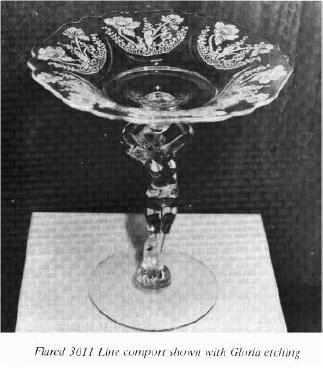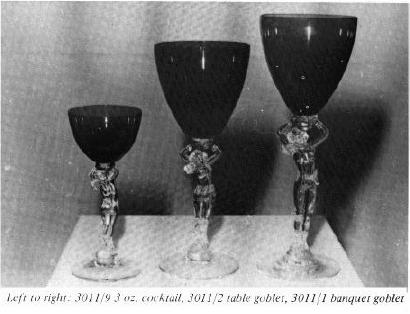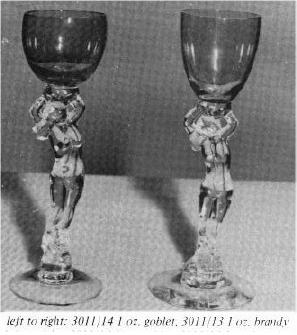National Depression Glass Association
Preserving America's Glass Manufacturing Heritage
Cambridge "Nude" stem - 3011 Line
by David & Joy McFadden,
Frank & Vicki Wollenhaupt
Glass Review - January 1978
The nude figure has long been recognized as an art form. Several companies have captured the nude figure in glass, but the most widely recognized and desirable for collectors is the nude stem by Cambridge (3011 line).
On November 24, 1931, a patent was granted to Will Cameron McCartney
for a design for a goblet. The patent describes the goblet as "a nude
 female figure occupying upstanding position with both arms upraised,
balancing upon the head, by means of the hands, an urn-like figure upon
which is superimposed the bowl of the goblet. Said figure is
represented as standing upon an elevated central portion of the base
with one foot and an adjacent portion of a leg enveloped by a fallen
gauze-like scarf. The arms are represented as occupying similar fully
exposed positions at opposite sides of and at substantially equal
distance from the head, and the unshorn hair is represented as falling
in a loose wind-blown mass over one shoulder. The opposite or reverse
side, of the stem shows the nude back of the female figure with the
disclosed forms of the Urn-like figure and the base repeated in all
substantial respects." This nude figure was first advertised in the
trade publications in October, 1931 (Reference: China, Glass end
Lamps Oct 1931, Page 12).
female figure occupying upstanding position with both arms upraised,
balancing upon the head, by means of the hands, an urn-like figure upon
which is superimposed the bowl of the goblet. Said figure is
represented as standing upon an elevated central portion of the base
with one foot and an adjacent portion of a leg enveloped by a fallen
gauze-like scarf. The arms are represented as occupying similar fully
exposed positions at opposite sides of and at substantially equal
distance from the head, and the unshorn hair is represented as falling
in a loose wind-blown mass over one shoulder. The opposite or reverse
side, of the stem shows the nude back of the female figure with the
disclosed forms of the Urn-like figure and the base repeated in all
substantial respects." This nude figure was first advertised in the
trade publications in October, 1931 (Reference: China, Glass end
Lamps Oct 1931, Page 12).
To our knowledge, the first catalog appearance of the nude stem was in a 1931 catalog (NCC Catalog Reprint, Page 31-23). The nudes shown on this page are seen with Plate Etching No. 744 - Apple Blossom or Plate Etching No. 746 - Gloria, on the bowl. To date, we have seen two comports etched Gloria (photo, above left) and one etched Apple Blossom. We have seen no drinking vessels etched in these two patterns. It should also be noted that drinking vessels made in this early time frame appeared with an optic effect in the bowl. Any nude stem items found with an etching should be considered scarce and should command a premium price.
In the l933 section of the NCC Catalog Reprint (page 33-30), various occasional pieces are shown in Crown Tuscan with gold silk-screen decoration. These were probably signed on the underside of the base with an acid stamp Crown Tuscan signature. Seldom are these seen with the gold in good condition. In 1934 {NCC Catalog Reprint Page 34-12) the Crown Tuscan occasional pieces are shown with an ebony foot. These should be considered very scarce.
In the 1934 section of the NCC Catalog Reprint (Page 34-2), is the first evidence of the wide variety of stemware shapes and sizes. Some of the more unusual shapes and sizes to be found are the 3011/1 Banquet Goblet, 3011/5 6 oz. Hoch, 3011/6 5 oz. Roemer, 3011/8 4½ oz. Sauterne, and the 3011/14 1 oz. Cordial.
 There were three different 3oz. cocktail bowl shapes available. The
easiest to find today is the 3011/9, which has a bowl shaped like the
table goblet. The other two cocktails were the 3011/11, which has a
bell shaped bowl, and he 3011/10, which has a cone-shaped bowl. Both of
these shapes are very difficult to find.
There were three different 3oz. cocktail bowl shapes available. The
easiest to find today is the 3011/9, which has a bowl shaped like the
table goblet. The other two cocktails were the 3011/11, which has a
bell shaped bowl, and he 3011/10, which has a cone-shaped bowl. Both of
these shapes are very difficult to find.
Few people realize the difference between a banquet goblet and a table goblet {see photo at right). The bowl on both is exactly the same size. The difference lies in the height of the stem. The banquet goblet stem measures approximately 6½", while the table goblet stem measures approximately 5½". These measurements are from bottom of foot to where the bowl connects to the stem. (Thus far, the writers have seen banquet goblets in amethyst and Carmen ONLY).
 There is also much confusion between a Brandy and a cordial (see
photo at left). The stem on both of these stems measures approximately
4½" in height and the bowl on each is 1 oz. The confusion lies
in the bowl shape - the 3011/l3 l oz. Brandy has a bowl shaped similar
to the goblet, while the 3011/14 l oz. Cordial has a much more rounded
bowl. The foot on the cordial is noticeably smaller in circumference as
compared to the Brandy. Cordials are more difficult to find and usually
command a higher price. At a later date, the Cambridge Glass Company
apparently discontinued the 3011/14 Cordial shape and the 3011/13
Brandy shape was then recognized by both names, as it is today.
There is also much confusion between a Brandy and a cordial (see
photo at left). The stem on both of these stems measures approximately
4½" in height and the bowl on each is 1 oz. The confusion lies
in the bowl shape - the 3011/l3 l oz. Brandy has a bowl shaped similar
to the goblet, while the 3011/14 l oz. Cordial has a much more rounded
bowl. The foot on the cordial is noticeably smaller in circumference as
compared to the Brandy. Cordials are more difficult to find and usually
command a higher price. At a later date, the Cambridge Glass Company
apparently discontinued the 3011/14 Cordial shape and the 3011/13
Brandy shape was then recognized by both names, as it is today.
One other item on page 34-2 of the NCC Catalog Reprint which should be considered RARE is the Covered Sweetmeat. To date the writers have seen only one of these, and it was Gold Krystol in color with the Apple Blossom etching.